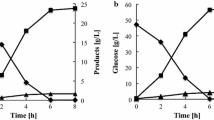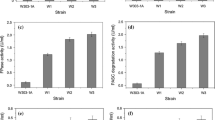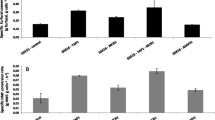Abstract
The FPS1 gene coding for the Fps1p aquaglyceroporin protein of an industrial strain of Saccharomyces cerevisiae was disrupted by inserting CUP1 gene. Wild-type strain, CE25, could only grow on YPD medium containing less than 0.45% (v/v) acetic acid, while recombinant strain T12 with FPS1 disruption could grow on YPD medium with 0.6% (v/v) acetic acid. Under 0.4% (v/v) acetic acid stress (pH 4.26), ethanol production and cell growth rates of T12 were 1.7 ± 0.1 and 0.061 ± 0.003 g/l h, while those of CE25 were 1.2 ± 0.1 and 0.048 ± 0.003 g/l h, respectively. FPS1 gene disruption in an industrial ethanologenic yeast thus increases cell growth and ethanol yield under acetic acid stress, which suggests the potential utility of FPS1 gene disruption for bioethanol production from renewable resources such as lignocelluloses.





Similar content being viewed by others
References
Burke D, Dawson D, Stearns T (2000) Methods in Yeast Genetics. A Cold Spring Harbor Laboratory Course Manual. Cold Spring Harbor Laboratory Press, Cold Spring Harbor
Ferrari MD, Neirotti E, Albornoz C, Saucedo E (1992) Ethanol production from eucalyptus wood hemicellulose hydrolysate by Pichia stipitis. Biotechnol Bioeng 40:753–759
Fogel S, Welch JW (1982) Tandem gene amplification mediates copper resistance in yeast. Proc Natl Acad Sci USA 79:5342–5346
He XP, Huai W, Tie C, Liu Y, Zhang BR (2000) Breeding of high ergosterol-producing yeast strains. J Ind Microbiol Biotechnol 25:39–44
He XP, Zhang BR, Tan HR (2003) Overexpression of a sterol C-24(28) reductase increases ergosterol production in Saccharomyces cerevisiae. Biotechnol Lett 25:773–778
Hill JE, Meyers AM, Koerner TJ, Tzagoloff A (1993) Yeast/E. coli shuttle vectors with multiple unique restriction sites. Yeast 2:163–167
Hottiger T, Kuhla J, Pohlig G, Fürst P, Spielmann A, Garn M, Haemmerli S, Heim J (1995) 2-micron vectors containing the Saccharomyces cerevisiae metallothionein gene as a selectable marker: excellent stability in complex media, and high-level expression of a recombinant protein from a CUP1-promoter-controlled expression cassette in cis. Yeast 11:1–14
Lee YY, Iyer P, Torget RW (1999) Dilute-acid hydrolysis of lignocellulosic biomass. Adv Biochem Eng Biotechnol 65:93–115
Luyten K, Albertyn J, Skibbe WF, Prior BA, Ramos J, Thevelein JM, Hohmann S (1995) Fps1, a yeast member of the MIP family of channel proteins, is a facilitator for glycerol uptake and efflux and is inactive under osmotic stress. EMBO J 14:1360–1371
Maiorella B, Blanch HW, Wilke CR (1983) By-product inhibition effects on ethanolic fermentation by Saccharomyces cerevisiae. Biotechnol Bioeng 25:103–121
Medina VG, Almering MJH, Maris AJA, Pronk JT (2010) Elimination of glycerol production in anaerobic cultures of a Saccharomyces cerevisiae strain engineered to use acetic acid as an electron acceptor. Appl Environ Microbiol 76:190–195
Mollapour M, Piper PW (2006) Hog1p mitogen-activated protein kinase determines acetic acid resistance in Saccharomyces cerevisiae. FEMS Yeast Res 6:1274–1280
Mollapour M, Piper PW (2007) Hog1 mitogen-activated protein kinase phosphorylation targets the yeast fps1 aquaglyceroporin for endocytosis, thereby rendering cells resistant to acetic acid. Mol Cell Biol 27:6446–6456
Mollapour M, Shepherd A, Piper PW (2008) Novel stress responses facilitate Saccharomyces cerevisiae growth in the presence of the monocarboxylate preservatives. Yeast 25:169–177
Nissen TL, Hamann CW, Kielland-Brandt MC, Nielsen J, Villadsen J (2000) Anaerobic and aerobic batch cultivations of Saccharomyces cerevisiae mutants impaired in glycerol synthesis. Yeast 16:463–474
Pampulha ME, Loureiro V (1989) Interaction of the effect of acetic acid and ethanol on inhibition of fermentation in Saccharomyces cerevisiae. Biotechnol Lett 11:269–274
Phowchinda O, Delia-Dupuy ML, Strehaiano P (1995) Effects of acetic acid on growth and fermenting activity of Saccharomyces cerevisiae. Biotechnol Lett 17:237–242
Tamas MJ, Luyten K, Sutherland FCW, Hernandez A, Albertyn J, Valadi H, Li H, Prior BA, Kilian SG, Ramos J, Gustafsson L, Thevelein JM, Hohmann S (1999) Fps1p controls the accumulation and release of the compatible solute glycerol in yeast osmoregulation. Mol Microbiol 31:1087–1104
Teunissen ARH, Holub E, Hucht JVD (1993) Physical localization of the flocculation gene FLO1 on chromosome I of Saccharomyces cerevisiae. Yeast 9:1–10
Wang ZY, He XP, Zhang BR (2007) Over-expression of GSH1 gene and disruption of PEP4 gene in self-cloning industrial brewer’s yeast. Int J Food Microbiol 119:192–199
Wang DL, Wang ZY, Liu N, He XP, Zhang BR (2008) Genetic modification of industrial yeast strains to obtain controllable NewFlo flocculation property and lower diacetyl production. Biotechnol Lett 30:2013–2018
Wysocki R, Chery CC, Wawrzycka D, Hulle MV, Cornelis R, Thevelein JM, Tamas MJ (2001) The glycerol channel Fps1p mediates the uptake of arsenite and antimonite in Saccharomyces cerevisiae. Mol Microbiol 40:1391–1401
Zhang JN, He XP, Guo XN, Liu N, Zhang BR (2005) Genetically modified industrial brewing yeast with high-glutathione and low-diacetyl production. Chin J Biotechnol 21:942–946
Zhang A, Kong Q, Cao L, Chen X (2007) Effect of FPS1 deletion on the fermentation properties of Saccharomyces cerevisiae. Lett Appl Microbiol 44:212–217
Acknowledgment
The authors would like to acknowledge the financial support of Knowledge Innovation Program of the Chinese Academy of Sciences (KSCX1-YW-11-C4).
Author information
Authors and Affiliations
Corresponding authors
Rights and permissions
About this article
Cite this article
Zhang, JG., Liu, XY., He, XP. et al. Improvement of acetic acid tolerance and fermentation performance of Saccharomyces cerevisiae by disruption of the FPS1 aquaglyceroporin gene. Biotechnol Lett 33, 277–284 (2011). https://doi.org/10.1007/s10529-010-0433-3
Received:
Accepted:
Published:
Issue Date:
DOI: https://doi.org/10.1007/s10529-010-0433-3




